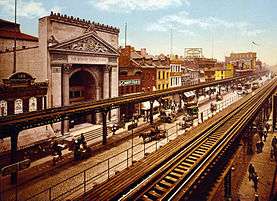Bowery Savings Bank
|
Bowery Savings Bank | |
|
Original headquarters, designed by Stanford White | |
| Location | 130 Bowery, Manhattan |
|---|---|
| Coordinates | 40°43′7.49″N 73°59′43.84″W / 40.7187472°N 73.9955111°WCoordinates: 40°43′7.49″N 73°59′43.84″W / 40.7187472°N 73.9955111°W |
| Built | 1893–95 |
| Architect | Stanford White |
| Architectural style | Other |
| NRHP Reference # | 80002672 [1] |
| Significant dates | |
| Added to NRHP | April 23, 1980 |
| Designated NYCL | April 19, 1966 |

The Bowery Savings Bank of New York City was chartered in May 1834 and is now part of Capital One Bank.
History
The Bowery Savings Bank opened in 1834 at the site of what is now 128-130 Bowery in Manhattan.[2] By 1980 it had over 35 branches located in the boroughs of Manhattan, Brooklyn, and Queens, as well as Nassau and Suffolk counties on Long Island. When bank deregulation was enacted the bank began to suffer losses as a result of rising savings account interest rates. By 1982 the bank was running out of cash; in 1985 the Federal Deposit Insurance Corporation (FDIC) arranged for the bank to be sold to Richard Ravitch and others. It was sold for $100 million and allowed to maintain a capital deficit of $220 million rather than pay out on the $5 billion in deposits. In 1992 it was sold to H. F. Ahmanson & Co for $200 million. The name was changed by 1993 to Home Savings of America. In 1995 Ahmanson sold their New York operations to Greenpoint Savings Bank. By 2004 Greenpoint had been sold to North Fork Bank, and in 2007 North Fork was sold to Capital One Bank.
From 1972 to 1992, baseball Hall-of-Famer Joe DiMaggio was spokesman for the Bowery Savings Bank.[3]
Timeline
- 5/1/1834 – New York State chartered the Bowery Savings Bank (5/1834–10/1985)
- 10/22/1920 – Universal Savings Bank acquired by merger
- 2/14/1949 – North River Savings Bank acquired by merger
- 2/11/1980 – Equitable Savings & Loan Association acquired by merger
- 10/1/1985 – Merge with The State Bowery Savings Bank
- 4/20/1992 – Name changed to Home Savings of America, Bowery Division, a state savings bank
- 9/1/1992 – Converted to Federal Home Savings of America, Bowery Division, a Federal savings bank
Buildings
130 Bowery and 124 Bowery:
The bank's first headquarters at 130 Bowery between Broome and Grand Streets was designed by Stanford White, from the firm of McKim, Mead, and White, and built in 1893–95.[4] The "L"-shaped buildings continues through to Elizabeth Street, and has a designed facade at 228 Grand Street.
White's choice of a Roman classical style for the building, a first, set a trend for bank buildings, first in New York, and then across the United States. The exterior features Corinthian columns and sculpted pediments by Frederic MacMonnies, while the interior gives the impression of a Roman temple, and is said to be one of the great spaces in New York.[4][5] It features the extensive use of marble, in the teller's counters – which are made of yellow Siena marble – the walls, and the mosaic floors. In addition, White employed faux marble scagliola columns, coffered ceilings and stairs and skylights made of cast iron.[4]
The exterior of the original building was designated a New York City landmark in 1966, and the interior in 1994.[4] It was added to the National Register of Historic Places in 1980. It is currently "Capitale", restaurant, night club and event space which is popular as a wedding site. In 2012, the connected building at 124 Bowery, designed by York & Sawyer and completed in 1902, was also designated a landmark.[6]
110 East 42nd Street:
The bank decided to move its headquarters in 1920, and a new building was constructed from 1921 to 1923 at 110 East 42nd Street between Park and Lexington Avenues across from Grand Central Terminal in Midtown Manhattan, New York City. It was designed by York and Sawyer in Italian Romanesque Revival style, with William Louis Ayres as the partner in charge.[7] The huge interior, which measures 65 feet high, 80 feet wide and 197 1/2 feet long, utilizes marble, limestone, sandstone and bronze screens to create a space reminiscent of a basilica.[7] It has been called "one of the great spaces of New York."[8] A six-story addition to the east, which came to be called "The Chapel", was built in 1931–33.[7]
The building was designated a New York City landmark in 1996. The ground floor is now a Cipriani restaurant and upscale event space.
References
Notes
- ↑ National Park Service (2007-01-23). "National Register Information System". National Register of Historic Places. National Park Service.
- ↑ "Bowery Savings Bank First Floor Interior" (PDF). Retrieved 24 May 2014.
The Bowery Savings Bank building, constructed in 1893-93 on the site of the bank's first building ... (established 1834)
- ↑ The American Experience
- 1 2 3 4 NYCLPC, pp. 46–47
- ↑ White & Willensky with Leadon, p.93
- ↑ Postal, Matthew. "Bowery Bank of New York Building Designation Report" New York City Landmarks Preservation Commission (June 26, 2012)
- 1 2 3 NYCLPC, p.107
- ↑ White & Willensky with Leadon, p.314
Bibliography
- New York City Landmarks Preservation Commission; Dolkart, Andrew S. (text); Postal, Matthew A. (text) (2009), Postal, Matthew A., ed., Guide to New York City Landmarks (4th ed.), New York: John Wiley & Sons, ISBN 978-0-470-28963-1
- White, Norval; Willensky, Elliot; Leadon, Fran (2010), AIA Guide to New York City (5th ed.), New York: Oxford University Press, ISBN 9780195383867
External links
| Wikimedia Commons has media related to Bowery Savings Bank. |
- Bowery Savings Bank Building at Emporis Buildings
- Photographs and architectural sketches of the Bowery Savings Bank Building


